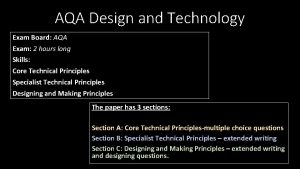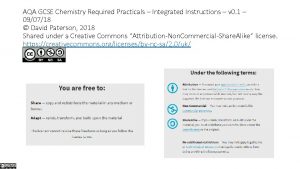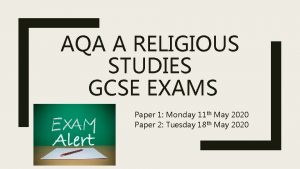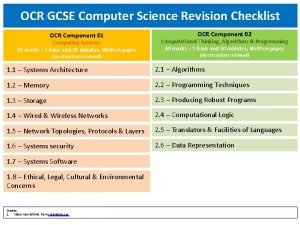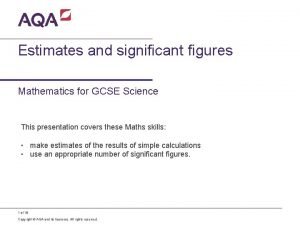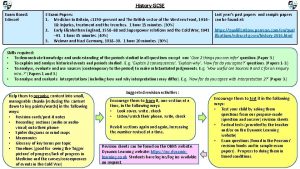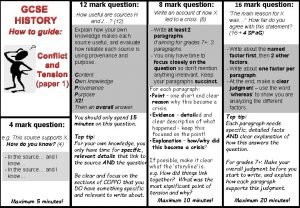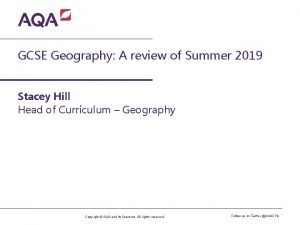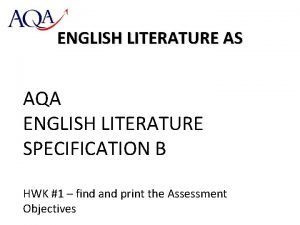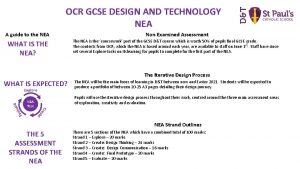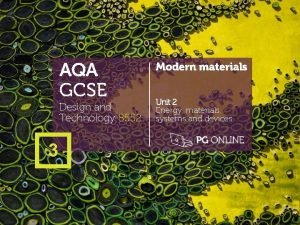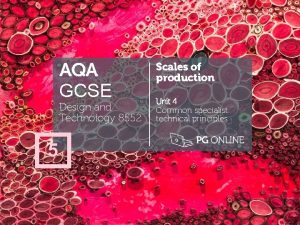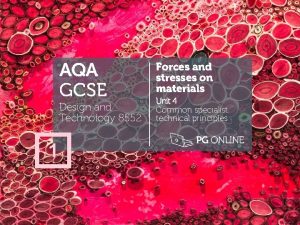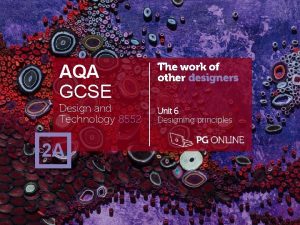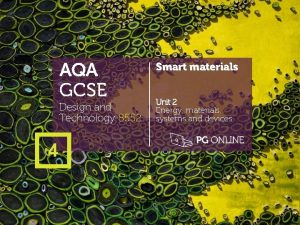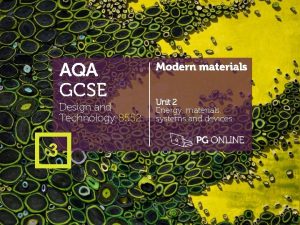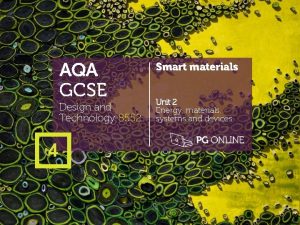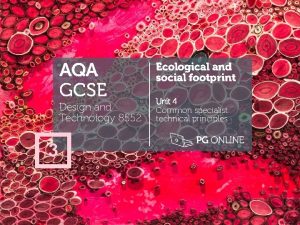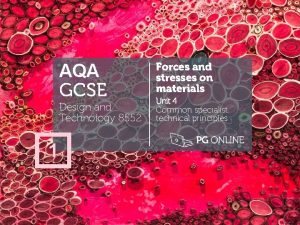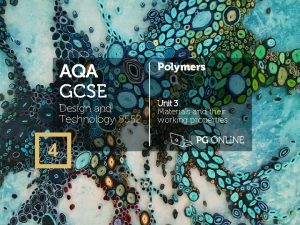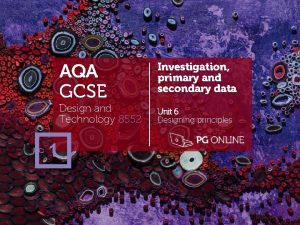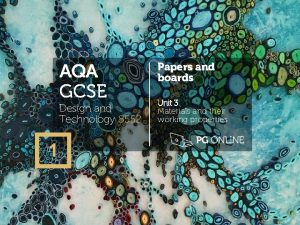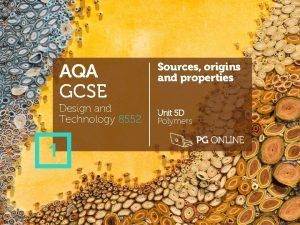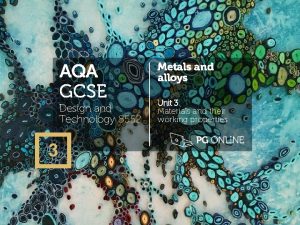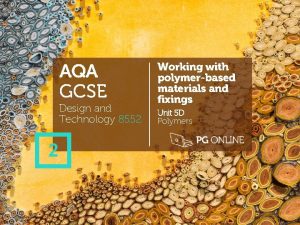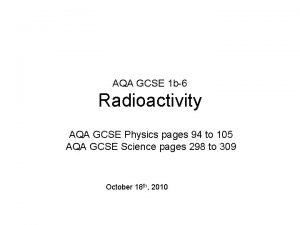AQA GCSE Design and Technology 8552 1 Energy





















- Slides: 21

AQA GCSE Design and Technology 8552 1 Energy generation Unit 2 Energy, materials, systems and devices

Objectives • Understand how power is generated from fossil and nuclear fuels • Understand how power is generated from renewable energy sources such as: wind, solar, tidal, hydroelectric and biomass • Be aware of the arguments for and against the selection of fossil fuels, renewable energy and nuclear power

Energy generation Unit 2 Energy, materials, systems and devices Where does our energy come from? • Name as many energy sources as you can think of • How is power generated from these sources?

Energy generation Unit 2 Energy, materials, systems and devices Fossil fuels • Fossil fuels are formed from the fossilised remains of plants and animals over millions of years • Coal, oil and gas are extracted through mining and drilling • Why are fossil fuels considered a finite resource? • Why are they so relied upon for power generation?

Energy generation Unit 2 Energy, materials, systems and devices Energy generation • Fossil fuels can be burned to superheat water under pressure, which in turn, drives turbines • How is energy from fuel converted to electricity at this point?

Energy generation Unit 2 Energy, materials, systems and devices What is fracking? • Fracking involves drilling into layers of shale rock deep in the earth to release pockets of gas • Water, sand chemicals are injected into a well in order to force gas back up – what could go wrong?

Energy generation Unit 2 Energy, materials, systems and devices Renewable energy sources • Renewable alternatives to fossil fuels include: • Wind • Solar • Tidal • Biomass • Hydroelectric • Why are these classified as ‘renewable’?

Energy generation Unit 2 Energy, materials, systems and devices Wind turbines • What are the arguments for and against wind power? • Would you want a turbine constructed beside your house?

Energy generation Unit 2 Energy, materials, systems and devices Wind turbines • What are the arguments for and against wind power? For Against

Energy generation Unit 2 Energy, materials, systems and devices Wind turbines Answers • What are the arguments for and against wind power? For Against Low maintenance Only work when windy Clean energy Eyesore to some Higher winter output Hazard to birds Low cost energy Noise

Energy generation Unit 2 Energy, materials, systems and devices Solar energy • The Sun produces a constant stream of solar energy that reaches Earth • In just one hour it provides enough energy to power the world for one year • In 2015, solar energy generation passed the 1% mark of the world’s energy requirement

Energy generation Unit 2 Energy, materials, systems and devices Photovoltaic cells • Light photons hit the PV cell which allows electrons to flow, creating an electric current • Where are PV cells used? • What are the advantages and disadvantages of PV cells?

Energy generation Unit 2 Energy, materials, systems and devices Solar energy • The advantages and disadvantages of using PV cells to harness solar power include: Advantages Disadvantages Low maintenance Seasonal fluctuations Clean energy No power generated at night Relatively low-cost Complex positioning issues

Energy generation Unit 2 Energy, materials, systems and devices Tidal energy • The rise and fall of the tide forces water through turbines which drive generators to produce electricity • What are the advantages and disadvantages of this system?

Energy generation Unit 2 Energy, materials, systems and devices Hydroelectric power (HEP) • Hydroelectric power is a very reliable and controllable energy source • The set-up costs are financially and environmentally expensive • Vast areas need to be flooded to create reservoirs • How would this affect those living locally?

Energy generation Unit 2 Energy, materials, systems and devices Biofuel and biomass • Biofuel and biomass are created from organic matter which is burned to generate power • Biomass fuels include food and farm waste, compost and wood chips or compressed pellets • Why is biomass considered to be carbon neutral?

Energy generation Unit 2 Energy, materials, systems and devices Nuclear power • Nuclear power accounts for over 11% of the world’s electricity • Is nuclear power a renewable energy source?

Energy generation Unit 2 Energy, materials, systems and devices What about nuclear power? • Nuclear power provides an abundant, reliable supply of clean energy • Why, therefore, is it so unpopular with some campaigners?

Energy generation Unit 2 Energy, materials, systems and devices Worksheet 1 • Complete Tasks 1 and 2 of the worksheet • Look at the mix of the UK’s electricity supply • Examine the arguments for and against nuclear energy

Energy generation Unit 2 Energy, materials, systems and devices Plenary • Explain the role heated water plays in producing electricity along with turbines • Explain how a mixture of energy sources can provide a reliable supply of electricity • Explain why fossil fuels are a finite resource • What is their connection with greenhouse gases?

Energy generation Unit 2 Energy, materials, systems and devices Copyright © 2017 PG Online Limited The contents of this unit are protected by copyright. This unit and all the worksheets, Power. Point presentations, teaching guides and other associated files distributed with it are supplied to you by PG Online Limited under licence and may be used and copied by you only in accordance with the terms of the licence. Except as expressly permitted by the licence, no part of the materials distributed with this unit may be used, reproduced, stored in a retrieval system, or transmitted, in any form or by any means, electronic or otherwise, without the prior written permission of PG Online Limited. Licence agreement This is a legal agreement between you, the end user, and PG Online Limited. This unit and all the worksheets, Power. Point presentations, teaching guides and other associated files distributed with it is licensed, not sold, to you by PG Online Limited for use under the terms of the licence. The materials distributed with this unit may be freely copied and used by members of a single institution on a single site only. You are not permitted to share in any way any of the materials or part of the materials with any third party, including users on another site or individuals who are members of a separate institution. You acknowledge that the materials must remain with you, the licencing institution, and no part of the materials may be transferred to another institution. You also agree not to procure, authorise, encourage, facilitate or enable any third party to reproduce these materials in whole or in part without the prior permission of PG Online Limited.
 Aqa a level art and design
Aqa a level art and design Aqa design and technology past papers
Aqa design and technology past papers Gcse pe 9 mark question examples
Gcse pe 9 mark question examples Aqa gcse geography revision checklist
Aqa gcse geography revision checklist Gcse history questions and answers
Gcse history questions and answers Chemistry vertical
Chemistry vertical Re gcse past papers
Re gcse past papers Ocr computer science checklist
Ocr computer science checklist Significant figures gcse
Significant figures gcse History edexcel gcse past papers
History edexcel gcse past papers Tangent questions
Tangent questions Aqa maths gcse revision guide
Aqa maths gcse revision guide How to answer a 12 mark question in history
How to answer a 12 mark question in history Kendal industrial park aqa
Kendal industrial park aqa Aqa gcse english literature specification
Aqa gcse english literature specification Sample design and technology gcse examination paper answers
Sample design and technology gcse examination paper answers Sample design and technology gcse examination paper answers
Sample design and technology gcse examination paper answers Www.technologystudent.com
Www.technologystudent.com World association of technology teachers
World association of technology teachers Design technology gcse coursework
Design technology gcse coursework Ocr art and design gcse
Ocr art and design gcse Aqa a level art and design
Aqa a level art and design

